By Ksenija Radulović
Just before the Covid 19 pandemic, the biggest cultural event of the season (even more – of the entire decade) in Serbia was The Cleaner, a retrospective exhibition by Marina Abramović. The exhibition was held in the Museum of Contemporary Art in Belgrade from 12 September 2019 to 20 January 2020. Before that the exhibition was staged in several European countries, with Belgrade being the last stop of the tour. There were several reasons for the enormous interest and debates in the public sphere that this exhibition sparked in Serbia.
First of all, Marina Abramović was born and spent her formative years in Belgrade, the capital of Serbia, which was also the capital of former Yugoslavia during the socialist era. She moved from there to the Netherlands (1976), and then to New York (2005), having built an incredible international career in performance art. The Cleaner was her first individual retrospective exhibition in her hometown after she had left it, over 40 years earlier. In the meantime, she had only performed in Belgrade within the framework of collective exhibitions or festivals. Her earlier statements about being sorry that her own country had not accepted her as an artist or that she did not have a place on the Belgrade cultural scene also contributed to the great emotional charge of the exhibition.
Abramović started her brilliant career in Belgrade and the key art pieces in the early phase of her work were connected with a legendary location in the local cultural life of the 1970s – the Students’ Cultural Centre. There, along with a group of young conceptual artists, she performed her works.
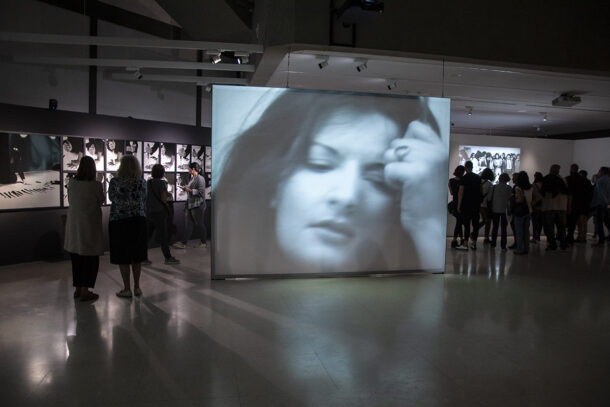
Marina Abramovic, The Cleaner, exhibition. Museum of Contemporary Art, Belgrade. Photo: Widewalls.
Belgrade curator Dejan Sretenović says that ‟after she and Ulay went to Amsterdam in 1976, Abramović worked on the international scene, alienating herself from the Yugoslav art scene and disappearing from the radar of local cultural institutions.” He adds that some time later, during the 1990s and the wars in former Yugoslavia, organising an exhibition by Abramović seemed unthinkable. Following this period, there were great political changes in Serbia: the regime of Slobodan Milošević fell in 2000, and democratic forces came into power (the first prime minister in 2000 was Zoran Đinđić from the Democratic Party, assassinated in 2003). There came a parallel shift in cultural policies as well. The new management of the Museum of Contemporary Art tried to organise an individual exhibition by Marina Abramović during the first decade of the 20th century, but to no success. First, the attempt to make the exhibition a partnership project of several European co-producers, one of which was supposed to be the Belgrade museum, failed. Then the Belgrade Museum tried to organize an exhibition on its own, in its own premises. According to public statements of the members of the team who worked on this project, the exhibition required enormous funding which exceeded the financial capabilities of the Museum and Abramović herself was unprepared to make concessions or decrease the amount of funding necessary to stage the exhibition.
In 2011, the artist received an invitation from the Serbian Ministry of Culture to represent Serbia at the Venice Biennale. According to written sources (texts and books in Serbian dedicated to the person and work of Abramović), she rejected the invitation in the end. Instead she decided to represent Montenegro, one of the former Yugoslav republics in the Biennale that year. Her performance at the Montenegrin pavilion in Venice was part of a project with a wider scope: the Montenegrin government had arranged for her to create a multimedia centre which would bear her name and be led by her in Cetinje (a town in Montenegro), in a former socialist refrigerator factory. In 2010, Abramović was awarded Montenegrin citizenship, and in 2012 she was awarded the most prestigious award given by the state of Montenegro (the 13th of July Award). On this occasion the artist emphasized that her family was originally of Montenegrin descent saying that this award was the most important one in her entire life. (It has to be noted that Serbia and Montenegro are neighbouring countries with close ties, with many Serbian citizens originally coming from Montenegro.) This ambitious project subsequently failed and during the recent opening of her Belgrade retrospective exhibition Abramović spoke about some of the unpleasant experiences she had during her efforts to open an art centre in Montenegro, stating, among other things, that it was all ‟very complicated.”

Marina Abramovic’s Balkan Baroque (1997), from The Cleaner exhibition. Museum of Contemporary Art, Belgrade. Photo: Bojana Janjic.
In 2012 once again great political changes took place in Serbia. The Post-Milošević forces (primarily the Democratic Party) lost the elections and Milošević’s political partners from the 1990s came to power again. The Cleaner exhibition was realized on the basis of a personal invitation and engagement of the current Serbian Prime Minister Ana Brnabić and as a state and art project at once. The negotiations pertaining to hosting Abramović’s exhibition lasted for several months in 2017 and ended in November that year with a visit by the Prime Minister and the then director of the Museum of Contemporary Art in Belgrade to Oslo for the opening of The Cleaner there.
The costs of the exhibition were high for Serbian standards, which was also a topic of discussion in the general public – given the relatively modest funds that Serbia earmarks for culture annually. The figure generally mentioned in public as The Cleaner’s budget was 1.5 million euros. Yet, according to an official statement it was actually 1.3 million and it was partly funded by the state, and partly by sponsors and donations. A VIP pre-opening night event was also organized, attended by some state officials.
The Cleaner was actually the first European retrospective exhibition by Abramović and its title alluded to performance art as a process of cleaning up the past and our consciousness. The exhibition was produced by Moderna Museet of Stockholm, in cooperation with the Louisiana Museum of Modern Art (Humelbæk), and Bundeskunsthalle (Bonn). It was curated by Lena Essling (Moderna Museet), with Tine Colstrup (Louisiana Museum of Modern Art) and Susanne Kleine (Bundeskunsthalle). After Sweden (2017), it went to Norway, Denmark, Italy, and Poland.
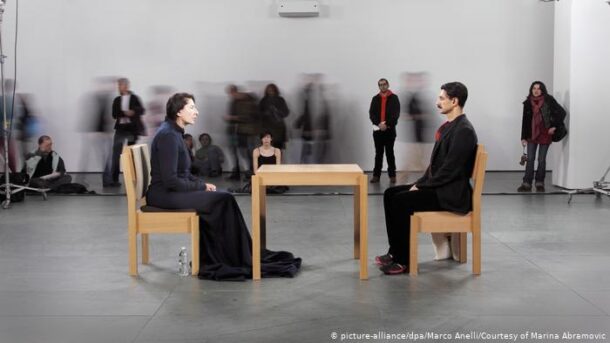
Marina Abramovic, The Artist is Present. Photo: Marie Abromovic.
In Belgrade the exhibition was organised by the Museum of Contemporary Art and its local curator was Dejan Sretenović, who partially adapted some of its parts to the Belgrade context. It has to be noted that The Cleaner came to Belgrade as a ‟finished product,” i.e. there was an initial core group of works in which, to a certain extent, local curators could intervene. The exhibition took up the entire interior of the Museum of Contemporary Art, on five levels. It covered all phases of Abramović’s work chronologically from the 1960s to present day, containing over 120 works: paintings, drawings, objects, photographs, audio and video pieces, films, scenography, and archives. The works also included some legendary performances, such as Rhythms (1973-7), Balkan Baroque (1997), The Artist Is Present (2010) … Live segments were an important part of the exhibition too – remakes of Abramović’s historic performances (both solo and with Ulay), which were performed by local and foreign “re-performers” during the entire run of the exhibition. In addition to this, Abramović also had a public lecture in the park in front of the Museum, attended by around 5,000 people, speaking about her life and work. At one moment she invited members of the audience to stand up, close their eyes, put their palm on the shoulder of the person next to them – and thus share unconditional love. Many found this reminiscent of a ‟guru,” and she remarked that ‟no performing artist has ever performed for a crowd this size, at least to my knowledge,, and added ‟this is the biggest event in my life.”
As expected, The Cleaner caused enormous interest both in the media and with audiences. With the exception of some (essentially insignificant) opinions, questioning the status of performance art per se, and thus the work of Abramović, this great event confirmed the artist’s exceptional importance. Almost all relevant figures on the Serbian cultural scene pointed to Abramović’s exceptional status in the sphere of performance arts on a global level. In the accompanying material for the exhibition, it was noted, among other things, that she is the only one of the generation of radical performance artists from the 1970s still active today.
The curator of Belgrade’s version of The Cleaner, Sretenović, put an emphasis on a fact that had hitherto gone unmentioned: over the past decades Abramović has done all kinds of performance arts, another thing that makes her unique, constantly pushing the boundaries and outreach of her art. ‟Just look at all the genres or types of performance art that she has tried her hand in so far: body art, duet performance, endurance art, spiritual performance, autobiographical performance, participatory performance art, performance-installation, object mediated performance art, site specific performance art, performance art with animals, re-performance art, community performance art, etc.”
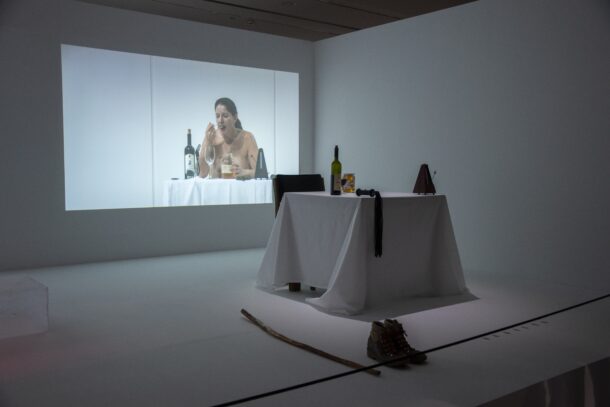
Marina Abramovic, Rhythm 10. Photo: Kooness.
Curator Slavko Timotijević noted that Marina’s key contribution was introducing/establishing performance art as mainstream, ‟regardless of its controversial perception in the general public.” As for the exhibition itself, he expressed a certain doubt that ‟the use of digital technologies and screens somewhat clouds its essence.”
In turn, the art historian and university professor Branislav Dimitrijević expressed his pleasure that his students would be able to see re-performances of Abramović’s historic performances, pointing out that he had already included the key phases/segments of the artist’s career into his syllabus.
Many art historians and theoreticians put special emphasis on the importance of Abramović’s Belgrade phase for the rest of her career. It was pointed out that her performances, especially those in the 1970s, were authentic and uncompromising. The renowned painter Uroš Đurić had earlier noted that Abramović played an important role in the market sphere – she put performance arts on the art market and was the first performance artist to make significant amounts of money.
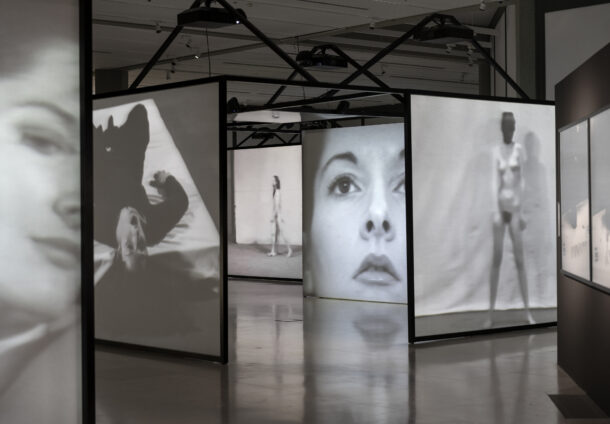
Marina Abramovic, The Cleaner, exhibition. Museum of Contemporary Art, Belgrade. Photo: Bojana Janjic.
When the exhibition was first announced, some figures on the cultural scene expressed their regret that Belgrade would get The Cleaner as a ‟finished product” rather than the exhibition be both initiated and created by Belgrade curators, all the more so because they would be the most familiar with Abramović’s early phase. Art theoretician Stevan Vuković saw this as ‟a great defeat for the Serbian scene, the scene where the artist came from,” and also as a ‟self-colonising gesture, where the Belgrade Contemporary Art Museum was put in the position of an institution which merely hosts a travelling blockbuster exhibition whose initial conceptualisation its curators played no part in.” According to him this meant that we are ‟a cultural backwater where you merely market finished products, not a partner in a dialogue from which art projects spring.” Vuković was not alone in his opinion – similar observations were heard from other theoreticians and curators too.
In spite of the general consensus that it was of undeniable importance for Belgrade to have the exhibition, there was also a debate around the special, “state-produced” character of this cultural event. Some voices on the cultural scene were of the opinion that the government used the exhibition for political marketing and for creating its own ‟symbolic capital.” The issues of participation, if not domination, of politicians in the sphere of cultural politics was raised (connected to the Prime Minister’s personal engagement) and of the role of Belgrade Museum as being ‟merely” organisational, with no key initiative or creative aspects.
A special topic of discussion was the current status of Abramović as a contemporary celebrity with a certain accompanying glamour and the latest phase of her work. Branislav Dimitrijević, one of the true connoisseurs of her earlier, legendary performances, has been very critical in recent years, speaking of the entertainment industry aspects of her art and ‟spectacles for the Hollywood jet set,” as choreographer Yvonne Rainer wrote following Abramović’s ‟Museum Canonisation” in New York’s MOMA (The Artist is Present, 2010). Similarly, Dimitrijević wondered how it was that a radical representative of contemporary art started to care so much for state accolades and ceremonial status in general, such those she enjoyed in Montenegro. However, Dimitrijević and Sretenović both hold that, unlike her ‟Montenegrin episode,” Abramović was more careful this time – her personal participation in the Belgrade version of The Cleaner did not cross the boundaries of art. Sretenović believes that a contributing factor was her reputation as an artist of international recognition who can set certain conditions and, at the same time, ‟request state guarantees” for such a large and expensive project. In other words, he is of the opinion that the political marketing of The Cleaner was cut to a reasonable size.
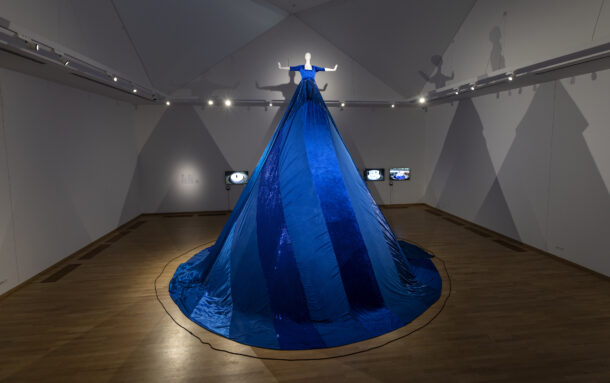
Marina Abramovic, The Cleaner, exhibition. Museum of Contemporary Art, Belgrade. Photo: Bojana Janjic.
‟The ambivalent relationship” between Abramović and Serbia was also a topic of interest. This was partially caused by her expressing regret that she had waited so long to have an individual exhibition in her own hometown and her dissatisfaction in principle with her status in and relationship with the environment she was born in. Especially interesting were also interviews and statements by some of Abramović’s previously close associates from her Belgrade phase. Dunja Blažević was among them, having been the director of Students’ Cultural Centre in the 1970s and the editor of its visual arts programme, as well as the person who ‟found room” for the then young artists. In her interview for Radio Free Europe, when asked if Abramović was commercialising her relationship with Yugoslavia, Blažević answered that ‟nothing that she (Abramović) said is true, that she had to paint flowers to sell her paintings; that she had to leave (Yugoslavia) to be able to work at all. “ It has to be noted though, that Blažević makes a clear distinction between the performances of Abramović that are ”an artistic interpretation of her own life” (‟I have nothing against this,” says Blažević) and the ‟books and interviews where she simply says things that are untrue.” She also said that, on one hand, The Cleaner was ‟a matter of politics,” and, on the other, it was ‟a spectacle.” Ljubomir Živkov, a journalist, was among the sharpest critics: without even entering into the artistic aspects of the exhibition, he gave the title of One-man Boycott to his article and explained why he was not going to see the exhibition. ‟If the artist does not care who invited her and how her host treats her subjects, why should I care about her mere skill or art? I will not be drawn to it, even knowing that New York repeatedly swooned at her art!” wrote Živkov.
Biljana Tomić, an art historian who has been working on affirmation of contemporary art since the 1970s, and was a one-time curator of Students’ Cultural Centre Gallery, was of a different opinion. She pointed out that it was ‟a brilliant exhibition,” and did not see anything “spectacular” in its staging. In addition, she explained the issue of the exhibition budget and state ‟intervention:” ‟Every exhibition costs money. It was thus in the Middle Ages and in the Renaissance, and here we still do not have the system of places like England, France, Germany, Italy, or America, where you can raise the money in a different way to realise certain projects.”

Marina Abramovic, Rhythm, from The Cleaner exhibition. Museum of Contemporary Art, Belgrade. Photo: Widewalls.
Ten days after the closing of The Cleaner, the Museum of Contemporary Art got a new acting director. One year previously, there was a public competition for the vacant position of museum director, with four applicants. The procedure had been practically suspended for a while, only for a fifth candidate to be selected – one who had not originally applied. Viktor Kiš, a ceramics artist and a sculptor, with no previous museum experience, became the new acting director. In one of his first public statements, Kiš said that the initiative for him to become the Museum’s director ‟originally came from Marina Abramović.” This statement was never subsequently either confirmed or denied.
This text is part of the scientific-research activities of the Faculty of Dramatic Arts (Belgrade, Serbia), financed according to the agreement with the Ministry of Education, Science and Technological Development.
Ksenija Radulović, PhD, is Associate Professor at the Faculty of Dramatic Arts, University of Arts in Belgrade, teaching History of Theatre and Drama. She was Director of the Museum of Theatre Arts of Serbia and editor-in-chief of the journal Teatron (2001 – 2012). She was also the artistic Director of Sterijino pozorje festival, which is the leading national theatre festival in Serbia (2010-2012). In 2009 she was the curator of Serbia focus programme at the New Drama Festival in Bratislava, Slovakia, and in 2007 she was the selector of Show case – Bitef / Belgrade International Theatre Festival. She writes regularly articles and reviews for Serbian and international journals. Since 2020 she has been Editor-in-chief of Anthology of Essays by FDA (Faculty of Dramatic Arts).

European Stages, vol. 15, no. 1 (Fall 2020)
Editorial Board:
Marvin Carlson, Senior Editor, Founder
Krystyna Illakowicz, Co-Editor
Dominika Laster, Co-Editor
Kalina Stefanova, Co-Editor
Editorial Staff:
Philip Wiles, Assistant Managing Editor
Esther Neff, Assistant Managing Editor
Advisory Board:
Joshua Abrams
Christopher Balme
Maria Delgado
Allen Kuharsky
Bryce Lease
Jennifer Parker-Starbuck
Magda Romańska
Laurence Senelick
Daniele Vianello
Phyllis Zatlin
Table of Contents:
- The 74th Avignon ‘Festival,’ October 23-29: Desire and Death by Tony Haouam
- Looking Back With Delight: To the 28th Edition of the International Theatre Festival in Pilsen, the Czech Republic by Kalina Stefanova
- The Third Season of the “Piccolo Teatro di Milano” – Theatre of Europe, Under the New Direction of Claudio Longhi by Daniele Vianello
- The Weight of the World in Things by Longhi and Tantanian by Daniele Vianello
- World Without People by Ivan Medenica
- Dark Times as Long Nights Fade: Theatre in Iceland, Winter 2020 by Steve Earnest
- An Overview of Theatre During the Pandemic in Turkey by Eylem Ejder
- Report from Frankfurt by Marvin Carlson
- Blood Wedding Receives an Irish-Gypsy Makeover at the Young Vic by María Bastianes
- The Artist is, Finally, Present: Marina Abramović, The Cleaner retrospective exhibition, Belgrade 2019-2020 by Ksenija Radulović
www.EuropeanStages.org
europeanstages@gc.cuny.edu
Martin E. Segal Theatre Center:
Frank Hentschker, Executive Director
Marvin Carlson, Director of Publications
©2020 by Martin E. Segal Theatre Center
The Graduate Center CUNY Graduate Center
365 Fifth Avenue
New York NY 10016
European Stages is a publication of the Martin E. Segal Theatre Center ©2020



